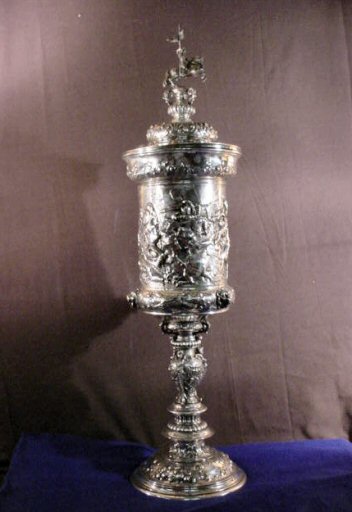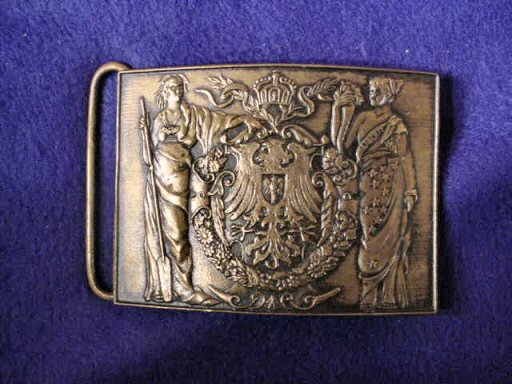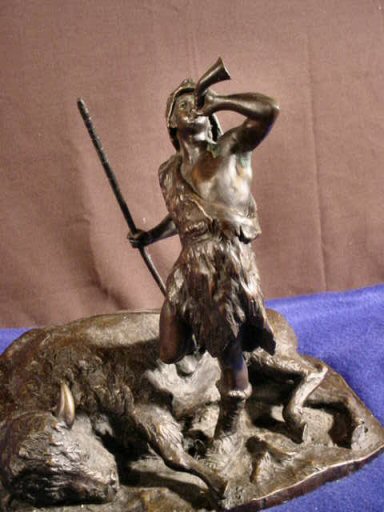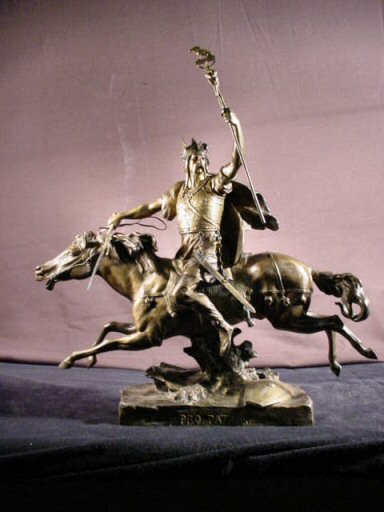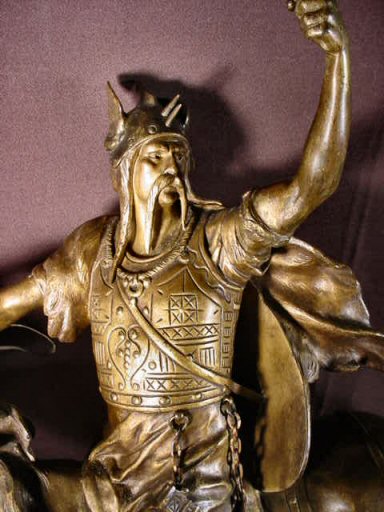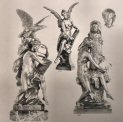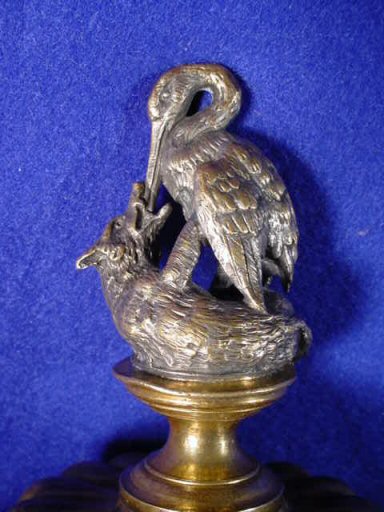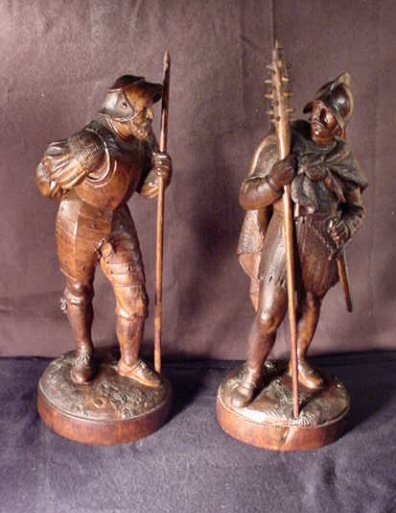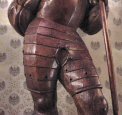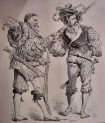
![]()


Old Reich
Page 5

|
|
|
|
|
|||||||||||||||||||||||||||||||||||||||||
|
Incredible Silver Chalice (Item OLD 5-2; POKALS 1-2) |
|||||||||||||||||||||||||||||||||||||||||
| DESCRIPTION: Yes, incredible: the mother of all chalices, goblets, Pokale, or whatever you will call it. This fantastic tribute to the art of early silversmiths is a museum piece extraordinaire standing almost 38 inches high. This is the tallest German Pokal that we have ever seen. The piece is most probably late 17th century and we just can’t get over the sheer beauty of it. The base shows hallmarks, but they are not clear. There are several, and one of them is a letter ‘N’ with what looks like a crown above it and a square punch with several dots inside; and both on the base and on the rim of the top you can perceive ‘840,’ the silver mark. This designation was shared in that era by both Germany and other continental nations, including Russia. ‘800’ is 80 percent silver and ‘840’ is even higher in fine-silver content. To completely describe this masterpiece of the silversmith’s art would take pages, but the main theme as you can see is the monumental battle scene, and what a scene; with spears being thrust, swords clanging against sword and shield, Roman Legion-looking soldiers, horses, dying men, hacking, thrusting, defending, attacking, etc. Below the battle landscape is a protrusion where among various armor, helmets, and weapons are depicted three fierce lions’ heads. Two of them still have rings in their angry jowls. Below this is another wreathed ring with griffon-style creatures that sit gargoyle style supporting the upper portion of the vessel. Below this is a section with bare-breasted, voluptuous maidens with wings that seem to stand guard over a grotesque creature whose face looks in fierce scowl and fanged caveat! Below this are three levels of plinth with seashell motif. On the bottommost extension of the base are engraved the words: “JOSHUA CONTRA AMMONITAS PROELIANTE.” Now this is a bit of a mystery since this vessel is German, without a doubt, and this legend is not written in German, but since a fantastic piece like this was in its day a treasure extraordinaire, it could have ended up in any land as a precious object d’art sold or traded. The writing to us looks added--probably a hundred years or so late--and our theory is that the unidentified battle must have been something only guessed at as to historic origin, and a silversmith, although wonderfully a master at his particular art, most likely was not likely also a historian. So the costumes of the battle participants would be done not so much accurately, but with much artistic license. We theorize that one of the owners in long past age probably thought that what he was seeing was indeed the biblical battle of Jericho, especially since in the background of the melee is seen a city with walls. Joshua fought in the Battle of Jericho and the (walls) came tumbling down. Seems only natural does it not? The lid is quite spectacular also with lots of floral splendor with its finial being a mounted knight in wonderful detail holding high the standard of his command. The mouth opening of the piece measures 9 1/2 inches in diameter. Incredibly, for its age, this “Pokal” is in excellent-plus condition with no apparent dings or dents. I believe everyone who owned it through all the years respected its fantastic beauty and importance and handled it with utmost care and gave it diligent, responsible stewardship. It certainly would be the item in any museum display that would capture the immediate attention of any history buff or true appreciator of the old metallic arts and it wouldn’t be something that you would only briefly examine. This is what would at least be a “10-minute stop” in the museum. We started this dissertation with the word ‘incredible.’ We end with this word, as well. Yes, this is almost an understatement, but in view of anything better at the moment, it will have to do. The consignor has priced this fantastic item far too low at $15,000 and he may change his mind in the near future. But, for now, we are very proud to offer this, the world’s best chalice: only the Grail might be a better find!
PRICE: SOLD |
|
|
|
|
||||||
|
Tiffinay German Buckle for Immigration Association (Item OLD 5-3) |
||||||
| DESCRIPTION: Here is an interesting belt buckle for an organization that existed on both sides of the Atlantic for promotion of German immigration into the United States called the Siedlungswesen, the American-German Immigrant Department. The German people long known for their love of organization, uniforms, authority, etc., are noted in history for applying these virtuous values to practically everything they touch. So, in the 1890s, up to WWI, was when this department functioned, and its main office was in the famous Gansevoort Market on little 12th St. in New York City, and on the back of the buckle is all this information as well as also Hamburg and Bremen. These were the ports, of course, that the Germans would leave from. Typical and traditional, officials would invariably be uniformed so they would in fact be recognized as officials. The uniform was rather grandiose with stripes on the trousers and lots of shiny buttons and an extremely ‘Bismarkian’ cap. This was the buckle that was ordered from the famous firm of Tiffany in New York City’s Broadway. The logo of Tiffany with the shield that has the ‘T’ surrounded by ‘N.Y.’ and its trademark Rare Stones is evident near the belt retainer. The design of the buckle’s front is spectacular with the turn-of-the-century German eagle in a beautiful floral wreath that surrounds the eagle. At the top is a fine image of the Imperial Prussian crown. The female figure at the left represents the adventure of sea travel (immigration) and the other figure represents the new land wearing the sash of Liberty and the stars of America. She also holds the horn of cornucopia representing the plentiful benefits of the American dream. This has to be the most beautiful and imaginative German buckle ever produced by a non-German jewelry and foundry company. It is solid bronze and large measuring 3 1/2 x 2 3/4 inches not counting the retaining loop.
PRICE: SOLD |
|
|||||||||||
|
Germanic Hunter in Bronze (Item OLD 5-5; ART 12-7) |
|||||||||||
| DESCRIPTION: Here is an original bronze sculpture of a Teutonic warrior with his kill (a buffalo). This is a very refined and greatly detailed work of art; probably late 19th century. The tribesman blows the call of the successful hunt, “Hallai!” This call harks back to centuries before even this hunter walked the German forests. The start of the hunt begins with the call of “Horido” and ends, if game is taken, with “Hallai!.” This is a very dramatic and descriptive sculpture—actually a museum piece of note. It is signed by the bronze master, who has “01” next to his name; is this the date 1901 or is this number 1 of a limited series? The artist’s name is hard to make out, but seems to be something like ‘Ottfer’ or ‘Ollfer.’ The length of the sculpture is about 14 inches measured across the base. The height from the bottom to the top of the hunting horn is 12 inches. The hunting spear is 9 inches long. This is a 100-percent original-period bronze sculpture dating from the turn of the 20th century. It would be something any museum devoted to European history would be proud to display. It’s in perfect condition and original.
PRICE: Price reduction from the consigner. This great bronze can now be purchased for $2,350.00--A super deal! |
| |||||||||||||||||||||||||||
|
Magnificent Bronze Statue of Germanic Warrior in Victory Passion (Item OLD 5-6; KSTATUE 3-10; ART 13-3) |
|||||||||||||||||||||||||||
| DESCRIPTION: In his hand held high is the captured standard of the First Legione Italica, the elite army of Rome. This legion had its permanent bases in Lugdunum, Gaul (Lyon, France) and in 11. 69 5th century AD at Novae (near Svistov, Bulgaria). In the 190s AD this army group built the fortifications along the Danube. The illustrious 10th Legion also used the boar for it emblem; mostly as an insult to the Hebrews in the cities of the Roman occupation; its being a direct affront to the custom and religion of Israelites. Throughout Roman military history there were a thousand conflicts with the Germanic tribes and the legions of the Roman emperors. The most important of these being the battle of the Teutoburgerwald when Publius Quinctilius Varus marched forward with three Roman legions to cross the Rhine to conquer the Germanic lands. He was met by Germanic tribesmen led by the warrior Arminius, (or Hermann, in German) the leader of Cherusci. Three Roman legions were totally wiped out. The outcome of the battle established the river Rhine as the boundary of the Roman Empire for the next few hundred years until the decline of the Roman influence in the west. The Roman Empire was never able to conquer GERMANIA, although many attempts were made. The tribes that Hermann was able to assemble for the fight were finally allied after centuries of warfare against each other. They were the Cherusci, Marsi, Chatti, and Bructen. They saw with Hermann’s convincing that they needed to come together finally to oppose a great, dangerous enemy. Varus never expected to be met with a now-united army of Germans. To see more about this, the most important battle ever fought from the German concept, go the Google and search Teutoburger Forest Battle and our site at Items OLD 4-7 and 4-8 and Item OLD 3-2. This magnificent bronze sculpture dramatically depicts a Germanic warrior in full regalia on horseback. He holds aloft the captured standard of either the first or 10th legion that has been defeated (note the boar symbol). On the ground below the galloping hoofs are the shield of the legionnaires and another fallen standard of another legion defeated at whatever battle this might represent. The warrior is clothed in the typical garb of the Teutonic tribes with the winged helmet so popular among the Cherusci and the Goths. The sword in his right hand is the very typical one used by the Germanic hordes. The bronze is by a French artist: These Teutonic or Gaulic statues usually are. It’s signed by E. Picault and has a stamping in a circle that says “Vrai Bronze.” Emile Louis Picault worked from 1860-1915. He had a 50-year career. He worked tirelessly producing approximately 1,000 exciting sculptures. His choice of subject was predominantly heroic men of action. Many extraordinary plaques and medallions have survived, while only a handful of busts exists. Among his repeated themes were memorial monuments, famous personages, blacksmiths, warriors, knights, and musicians. These were often accompanied by inspiring inscriptions drawn from the Latin language. He is recognized as one of the greatest bronze sculptors of Europe in the 19th century. This bronze of the victorious Teutonic warrior is a classic example of his magnificent work. We show a few of his other sculptures from the four-volume set Bronzes, Sculptors, Founders 1800-193 by Harold Berman. In this bronze both man and horse are in the finest detail. It is most dramatic indeed. The accuracy of the equipment is phenomenal: the sword, the shield, the helmet, the scabbard are just historically correct in every way. The horse is especially great. The sun symbols on the horse blanket and the man’s vest indicate sun-worshipping tribal faith. The base contains the words in Latin Pro Patria that translates to “For Fatherland.” This is appropriate because of the subject portrayed. This is an exciting sculpture in wonderful condition. It’s historically important and a great collector’s item for a faithful Germanophile.
PRICE: SOLD |
|
|
|
|
|
|||||||||||||
|
Fantastic German Fable Goblet (Item OLD 5-7; POKALS 1-3) |
|||||||||||||
| DESCRIPTION: For those whose passion includes collecting goblets or Pokale we now introduce you to the ultimate in this particular field of collecting. This one is practically breathtaking in its appearance and elegant quality. This vessel is without a moment’s doubt one of the greatest we have ever seen. One would at least expect to be viewing through glass in a ‘green room’ at Dresden or possibly the Museum for Folk Treasures in the old city of Nuremberg. This is a wonderful showpiece demonstrating the fantastic skills of mid-19th-century craftsmen in the German fatherland. The casting skills and silver adornment are especially noteworthy. At the middle of the piece are placed the bust portraits of two Grecian-looking gentlemen whom we think might be statesmen or writers who were instrumental in chronicling the fables of Aesop, the storyteller of ancient Greece, whose tales and fables survived the centuries. Many artistic features on this goblet are possibly attributable to Aesop’s fables: right from “The Fox and the Crane” on the finial, down to the reptiles and amphibians displayed on the cup’s base. All through the goblet’s motif you can observe various animals that would fit into the master storyteller’s sagas: wolves, dogs, sheep, rams. Go to Google and search for “Aesop’s Fables” and you will see the story about the fox and the crane and others that will include all of the animals shown on this piece. The “handles,” in lieu of a better word, are cast in the depiction of cherubs that seem to be gaily using the appendages as a swing. The front and back have scenes of wolves in various poses crafted in silver and placed within a forest environment. Note the great artistic style used in the placement of the monkeys’ tails. Somehow I believe that this might be a commemorative Pokal struck in honor of Aesop and his Grecian tales. The Pokal stands about 14 1/2 inches high and is about 6 1/2 inches wide not accounting for the handles. The condition is perfect throughout except for a nut that had to be replaced at the bottom (under the base). This was done to tighten it up since it had come loose after many years of handling. It is a treasure indeed and possible very historically important, as well. It’s quite heavy as it is crafted in solid gilted bronze. This could be featured in any good book of reference to European works of fine art. Spectacular!
PRICE: SOLD |
|
|||||||||||||||||||||||||
|
Two Carved Wood Landsknecht Sculptures in Wood (Item OLD 5-9; LAND 1-9; KCARVING 1-4-) |
|||||||||||||||||||||||||
| DESCRIPTION: These are truly magnificent museum pieces in every sense of the word. Against carvings recently done in Bavaria or the Black Forest region there is absolutely no comparison. The figures are absolutely worthy of being featured in a museum or advanced art gallery. We have in many years never seen finer examples although we have viewed some of Germany’s greatest collections of wood sculpture and just nothing quite compares. The accuracy of the costuming, the human countenance of the faces, the deployment of their armor all go to speak of masterpieces in wood. From what we have been able to garner in information about when these figures were carved from German sources we are led to believe that they probably were executed in the mid 19th century and the work is considered extra typical of the carving of the south Tyrol. The armor and other costuming of the sculptures suggest historical depictions that would be from that area, as well. The figures depict Landsknecht militiamen of the first third of the 16th century. Note that we show pictures from museum sources of similarly attired Landsknechtsoldaten. The difference between the Swiss and northern Landsknecht was mainly in the style of the weapons used. The sword seen worn by one of the figures differs in that it does not have the typical s-curved cross guard. The mace he holds is the long version that was used not only as a head crusher, but because of its length, it was very effective in bringing an enemy down from his horse in a quick motion. The pole arm held by the other figure is a simple staff with what usually had an iron point. Simple, but deadly, it could be thrust into the adversary piercing chain mail or it could be hurled through the air at the enemy soldiers. The figure holding this weapon is suited in excellent armor garniture and wears an iron helmet. His upper torso is covered in chain mail. His blouse is of the typical Landsknecht flamboyant style. The armor covers only the chest and upper leg area. His back has no vital covering. The other figure wears no actual armor, but has a full tunic of chain mail. He wears a full protective helmet and the cloak usually worn by officers. The cloak was often of bright woolen weave. The figures measure between 14 and 15 inches generally, not counting the height of the weapons. The faces of these men are individual, but the artist has put true character in each one. They could practically breathe; they are so realistic. So what you see here are examples of the pride of Germany’s wood sculpture art. These figures could hardly be executed today even by the best of the Tyrolian carvers. The condition is excellent. The figures will be sold as a set, only.
PRICE: Consigner has allowed us to significantly reduce the set. Please inquire. |
Page Five |
Please refer to item designator in parentheses in all correspondence.
Please E-mail for any additional information you may need.If you prefer, contact 'Germania' at PO Box 68, Lakemont, GA 30552
or call at 706.782.1668 or 706.782.4398.
Please! do not call during the wee hours of the morning. The best time for calling us is between 10 and 11 am and between 9 and 11 pm eastern time.
